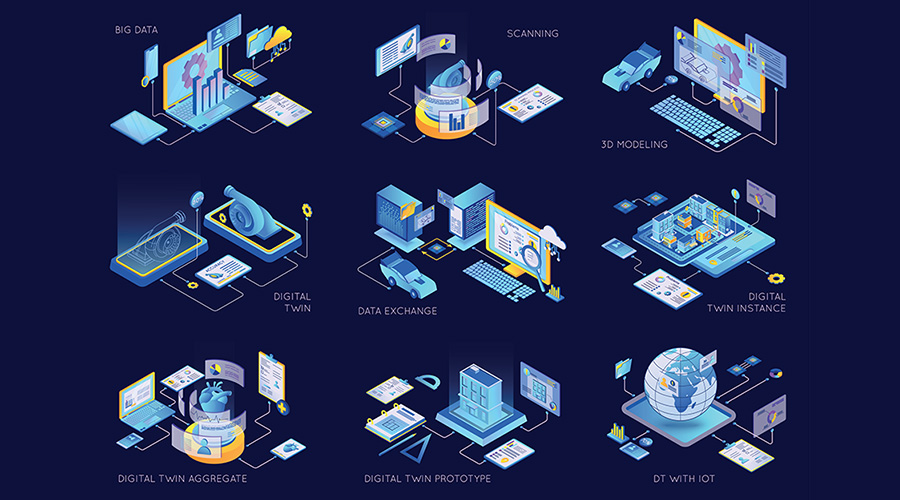High-Level Operations
Kaiser Permanente turns to a corporation-wide CMMS to generate greater efficiency in its expanding facilities
Selecting and implementing a computerized maintenance management system (CMMS) can be an arduous process. The process can be even more arduous for organizations with multiple buildings, especially if those facilities are spread across the country and have different CMMS for scheduling and tracking maintenance activities.
For the last two years, Don King, national director of maintenance operations consulting services for Kaiser Permanente, has played a central role in selecting a corporation-wide CMMS for the organization’s 900 facilities in 9 states and Washington, D.C. The goal of the project is to provide all of Kaiser Permanente’s maintenance employees — both at the local and corporate levels — with a consistent, effective tool to track and schedule preventive maintenance (PM), identify areas for process improvement, and target better ways to spend maintenance dollars.
Kaiser Permanente’s CMMS project team will launch the new web-based system at select locations this March. By July 2005, the system will be operating in all facilities, with more than 3,000 maintenance employees using it daily.
“Kaiser Permanente has common expectations for all of its facilities,” King says, adding that the challenge has been made even greater by Kaiser Permanente’s ambitious construction program. See the accompanying article.
Unique Perspective
King has been able to view the CMMS selection process from a unique vantage point.
“There are some national directors of maintenance operations who do have a line of accountability, but I haven’t really seen someone that has a role quite like mine at a corporate level,” says King, who considers himself an internal consultant for Kaiser’s maintenance operations. “My job is truly management through influence.”
More than 3,000 people work in maintenance operations for Kaiser Permanente. While only four people report directly to King, he is accountable for the bottom-line performance results of all Kaiser Permanente facilities.
Reporting to Kaiser Permanente’s vice president of national facilities services, King is responsible for establishing best practices in maintenance and operations and overseeing biomedical engineering, as well as developing facilities performance metrics, information systems, and energy management strategy and policy. From his vantage point in the organization, King is able to see both the corporate and the local facilities perspectives.
National Standards
Until now, Kaiser Permanente’s maintenance managers at the local facilities have used a variety of applications, and many of them categorize and sort information differently. As a result, one of the biggest challenges in the project has been setting national standards for equipment classification and maintenance requirements.
“Prior to standardization, one facility might have classified boilers on their maintenance records under three categories — large, small, and extra large — while everyone else had one generic category called boilers,” King says. “From a corporate level, this makes it really hard for us to develop standard maintenance requirements because the boilers are not categorized the same way.
“Under a national standard, we might categorize boilers as those under 50 hp and those over 50 hp. Then, we can be certain that when we collect the data from the various facilities, we have an apples-to-apples comparison.” Setting corporation-wide standards also means that local maintenance managers no longer will have to make decisions regarding equipment classification and priorities.
“The local facility managers won’t have to make so many decisions on how to classify equipment and what to call work priorities because corporate standards have already been established and are built into the system,” King says.
Local Reaction
The maintenance staffs at the facilities have been generally receptive to adopting a new standardized CMMS.
“There are always concerns when you implement a new system,” King says. “They want to know they will be able to do their daily work with the system, and the vendor is going to provide support.” It also might be difficult for some staff to cope with job changes brought about by the new CMMS.
“One of the consequences of going with a national package is that it won’t ever be 100 percent of what everyone wants,” he says. “But we’re convinced the system will meet their core requirements, give them flexibility to meet future requirements and give us a corporate platform to expand on in the future. It will help them get their work done, give them corporate-level benefits and help us as an organization prepare ourselves for moving to the next platform of maintenance management, which may be a suite of applications.”
While the system serves as a national template, it will allow some flexibility at the local level, King says. Local managers will be able to maintain employee records and modify (PM) due to local needs.
Corporate Benefits
Managers at both the local and corporate levels will reap benefits from a corporation-wide CMMS.
“As a local or regional person, I would expect someone at the corporate level with expertise in the application would be able to help me extract the information that I need from it,” King says. Besides technical support, maintenance managers at the facilities would be able seek corporate assistance in determining what the information generated by the CMMS means to operations. If the information identifies a problem, someone at the corporate level could help develop a solution.
For employees on the corporate level, the new system also will provide information useful in making decisions on equipment standards and contracts with manufacturers.
“My goal is to collect information from the system to help us identify better maintenance practices, as well as products and systems that work best for us on a life-cycle basis,” King says. “I want to know what’s working and what’s not so I can look at equipment from different manufacturers and, based on maintenance history, decide which one makes a better national standard for Kaiser.”
The system could also help maintenance technicians develop a program for reliability-centered maintenance.
“We wouldn’t just maintain equipment based on our best guess of the maintenance requirements and manufacturer recommendations, but also on the actual failure modes of the equipment and maintenance intervention for those failures,” he says. Such a program would better prioritize maintenance efforts.
“The easiest way to get caught up on your preventive maintenance is to put your time where it gives you the best value and make sure you’re not over-maintaining systems,” King says.
Strategic Launch
The project team decided to launch the CMMS in phases.
“We believe to implement everyone at the same time would be a huge drain on corporate resources,” King says. “We’re staffed very lean and wouldn’t be able to answer everyone’s questions at the same time,” he says.
To minimize questions, the team is launching the system first at less complex operations, where they expect users will place less demand on the application.
“The team can then use those launches as learning experiences and use that knowledge for subsequent applications,” King says. “The launches will become smoother over time. As the team approaches the larger and more complex implementations in the larger regions, it will have a lot of lessons learned from the earlier implementations.” King feels confident the system will help the maintenance staff better support Kaiser ’s mission.
“The physical environment within which we deliver health care to the people we serve is critical to the quality of that health care,” King says. “I believe Kaiser Permanente decided early on that they wanted to be stewards of their facilities.” He points to the new CMMS as an example of that commitment.
By implementing a corporation-wide CMMS that will recoup its costs within five years and begin lowering the organization’s bottom line, the maintenance staff can ensure that the minimum amount of patients’ money is diverted away from direct health care.
A Cooperative Effort in Selecting Software
Ensuring a new computerized maintenance management system (CMMS) fulfills the needs of everyone affected as much as possible requires a team effort. Ideally, these projects would include input from maintenance staff at different levels of the organization to achieve this goal. Such was the case for Kaiser Permanente, which will launch a new CMMS for use in its 900 facilities in March.
“Instead of having a few people from the corporate headquarters make all of the decisions in the CMMS project, we involved experts from the field,” says Don King, Kaiser Permanente’s national director of maintenance operations consulting. “The people who have helped us select the application also are the ones who manage and operate the facilities and actually will use the system.”
Kaiser Permanente's project team consists of about 55 people who represent plant operations and maintenance, biomedical engineering, national facility services, and information technology. Team members have met primarily as subgroups, which focused on implementation planning and training, as well as developing standards for biomedical engineering and plant operations. Teams also are organized regionally, which allows greater flexibility in assigning duties.
“In the larger regions, we might have someone in charge of training, someone in charge of implementation, and another person in charge of standards for plant operations. In some of our smaller regions, one person might have all of these roles.”
King also hired a project coordinator who is responsible for managing the application's rollout. After implementation is complete, the coordinator will serve as the corporation’s CMMS resource and will manage system upgrades and changes. With so many involved and so many decisions being made, supplying everyone with current information has been challenging.
“We have tried several communication methods,” including e-mail, King says. “Unfortunately, the e-mails are so frequent that it’s difficult to read them all, and it’s hard to discern which ones affect you.”
Project team members also have posted information to the corporate web site.
“The challenge there, however, is that people have to make an effort to visit the site,” King says. “There is some discipline required on their part to look at it, and they don’t always do. Also, because the implementation process is moving so quickly, the project team has been challenged to post the latest information on the site.”
King found peer groups to be the most effective way to communicate.
“When you’re in a matrixed environment, your empowerment comes through the peer groups,” he says. “For example, in California, we have a handful of people that represent the facilities out here. When they come to a really critical juncture, they’ll take a decision back to a peer group and ask them for guidance on it. By far, peer-level meeting interaction has been best.”
While not everyone is represented at the peer groups, he says, team members make an effort to reach out to individuals seeking to give suggestions.
|
Software That Saves
Kaiser Permanente is planning to spend billions of dollars over the next several years on new and replacement medical centers. To help improve budgeting for staffing these new facilities, as well as to improve maintenance practices, Kaiser Permanente is turning to its new computerized maintenance management system (CMMS) for more accurate information, says Don King, Kaiser Permanente’s director of maintenance operations consulting services.
Because maintenance managers often find it difficult to budget for their departments, many of them develop their budgets by using models based on square-footage, King says. This traditional approach might not be the most accurate, however.
“For the majority of our new construction, our goal is — once we have enough history in the CMMS for equipment and systems — to pull out actual maintenance requirements for the systems,” King says. “Then, all we’re left to do for the square-footage model is basic facility maintenance items, such as replacing light bulbs and patching paint. We believe this method of budgeting is going to save 5-10 percent of our future staffing.”
|
Related Topics:











